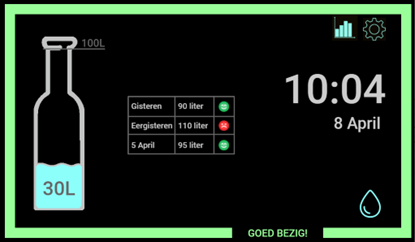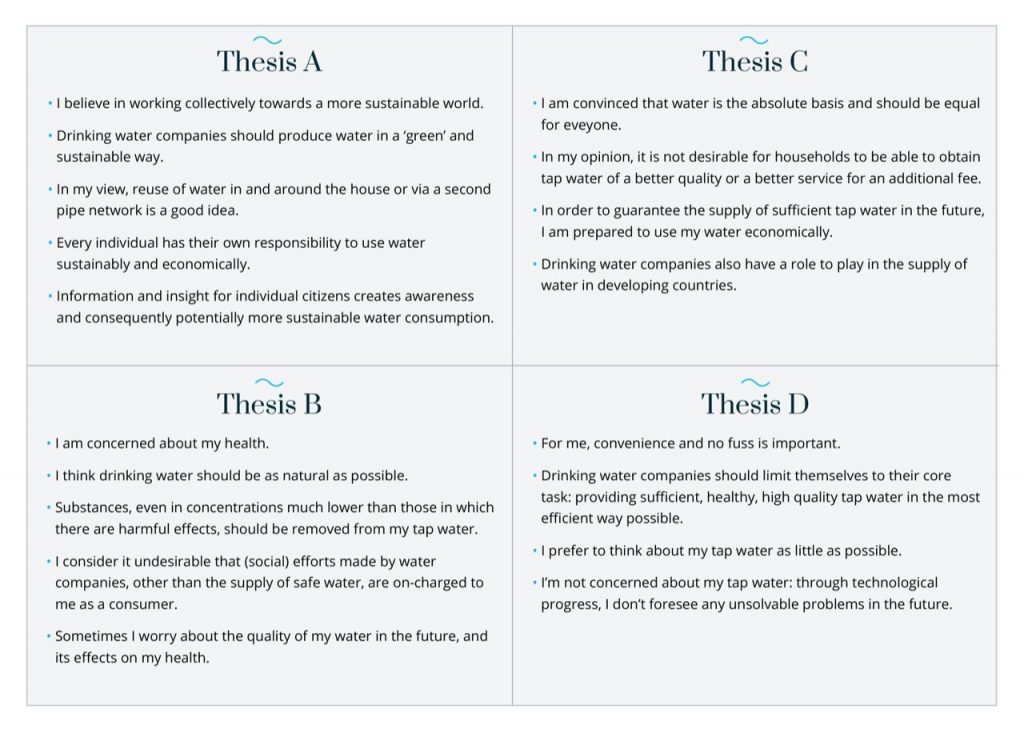Drought, a growing demand for water and increased pressure on drinking water sources are issues of constant concern in the water sector. Besides ensuring the safety of water sources, conserving water is becoming more and more crucial. The Smart Water Conservation project investigated the extent to which smart water meters, supported by behavioural science insights, can move consumers towards water saving. Useful work, in the view of De Watergroep’s Cindy Vanderstraeten. ‘Drinking water is the new gold. And I see the digital water meter as a means of safeguarding that new gold.’
For the Flemish water utility De Watergroep, the need to address the matter is not too far off. In 2030, all Flemish households must be equipped with a digital water meter. As a partner in the Joint Research Programme of KWR and the water utilities, De Watergroep gladly joined the Smart Water Conservation project. ‘We had already run several pilot projects with smart water meters,’ says Vanderstraeten, Programme Manager, Digital Measurement Systems, at De Watergroep. ‘These indicated that the existing networks are not capable of receiving data from the digital meter in the home and sending them to the water utilities’ servers. This project developed a tool which now makes this possible. The problem has therefore been solved, and we can now process the data further in our systems.’
Raising water conservation awareness
For De Watergroep this project means that greater insight can be gained into domestic customer attitudes towards water conservation. Vanderstraeten: ‘Up until a couple of years ago, having water flowing out of the tap was something people took entirely for granted. But because of the drought experience and increased prices, they have begun to see things differently. I think that we should put more effort, as a water utility, into presenting a clear picture of what the provision of clean and sufficient drinking water entails. The awareness of the need for water conservation is still far too low. The smart meter can be of assistance here.’
Behavioural science impact
During the Smart Water Conservation project a software application concept was developed [WaterInzichtPakket (Water Insight Package) or WIP] linked to measurement data from fifty households with a digital water meter and a data logger. A visual display with a user’s menu presents the user with information, taking into account the desires, needs and beliefs of different customer perspectives or profiles. KWR researcher Stef Koop explains: ‘It makes little sense to simply install a smart meter in a house. In the first three to four months the people are enthusiastic and keep an eye on their water consumption. But several international studies show that once the novelty wears off, people return to their old behaviour. This is why you have to combine smart meters with behavioural science insights. For example, by smartly comparing the water consumption with that of the neighbours. With a couple of customer data elements, such as shower temperature, we have linked water consumption to the reduction in a person’s CO2 footprint for drinking water production, transport, wastewater treatment and, most of all, the heating of the water in the home. The core of our approach is to offer regular tips that responds to a person’s personal water consumption patterns and that remind people of their water-saving goals and associated motivations. The current circumstances are also a factor, for instance, in the event of a heat wave. This has a much more powerful impact on bringing about water conservation over the long term.’

Example of the WaterInzichtPakket (WIP) user screen, with feedback on the personal water-saving goals, tailored to the relevant customer profile.
Five percent water saving
Micha van Aken, Business Development Manager at Vitens, also sees smart meters as an indispensable link in the whole pallet of water conservation measures. For Vitens, a water utility with a supply area that encompasses a large part of the dry sandy areas and that makes use of groundwater, the water-saving incentive is strong. ‘Over five years ago I was already busy using serious gaming to see how we could reduce water consumption peaks,’ says Van Aken. ‘But we have to go much further than that. Take a look at the energy sector, and how it is active in the installation of solar panels on roofs, with energy-neutral building. How can we today install the same water infrastructure in new buildings that we were installing a century ago?’ Van Aken put great effort into getting water conservation on his employer’s agenda – and he succeeded. Vitens strategy now includes a 5 percent water-saving target. ‘With the smart meter, we have a means of stimulating that water conservation. For instance, through water rate differentiation, or by offering insights and feedback on the water consumption. Thanks to a smart water meter we no longer have to take a shotgun approach in our communication: a general campaign against watering gardens when it gets hot, produces little net result. If the message is to truly register, we have to reach people individually. For this we need the insights of behavioural science.’
Exploratory research
Researcher Koop stresses that smart water meters and customer-oriented approaches, such as the WIP, are largely uncharted territory in the Netherlands. ‘With this exploratory research, we looked ahead to find out whether we could effectively encourage customers, on the basis of their profiles, to reduce their water consumption. One of our follow-up projects for example is Smart Water Networks, in which we further develop the technology underlying the WIP through the use of water-consumption data. And, in the longer term, we want to further elaborate and implement the WIP approach jointly with a technology developer. What I see happening is that this advanced application of smart water meters will be used primarily in new buildings, and in places where water saving is most needed and where people are the most receptive to it. One survey we conducted showed that the vast majority of people would immediately agree to having a free smart water meter installed, and that they also have no objection to their utility investing in such meters. This makes me optimistic. The customer seems ready for it.’

From the attitude: ‘you focus on people who would gladly save water’, it is easy to determine for whom the developed Water InzichtPakket (WIP) is most suited. These are people who most identify with the statements under A and C: approximately 60% of Dutch people.
Legal and regulatory framework
Actually, things should be moving much faster when it comes to water conservation. Although the shift in the societal and political debate is evident, the Dutch government has not yet moved as much on this compared to the Flanders case. There is for instance as yet no legal or regulatory framework to encourage the installation of smart water meters, not to speak of an obligation to do so. Even in new building projects – including the famous 1 million homes that need to be built – the subject receives hardly any attention. Why is this so? ‘Worldwide, Belgium occupies the fourth position of countries with the smallest water reserves,’ explains Vanderstraeten. ‘And our distribution network is very old, and leaks away valuable water from which we, as a water utility, earn not a cent. Moreover, we have to present our annual financial statements to the Vlaamse Milieumaatschappij – the water, air and climate adaptation watchdog. There is therefore huge pressure from above. I think that the Dutch approach is different. You have always had to struggle against water. When one sees how tightly you have organised it all: the water discharge, the flood protection and so on. I think that’s the central concern, which means that drinking water only enters the picture later. And direction from the government is absent.’
Flattening rising water demand
Water conservation has now become the biggest priority at Vitens. In Westeinde, an existing neighbourhood in Leeuwarden with a mix of housing types, smart meters are the subject of intensive experiments. More than 1400 households are taking part. ‘We are looking at the technical side,’ says Van Aken. ‘How should the meter be installed, how do we get the data we want, how reliable is this information and what can we do with it. But also: how do we feed the data back to the customer, and what does this contribute to water saving. Water demand is growing as a result of all sorts of circumstances. Historically our reflex response has been: we need to ramp up capacity. But now the penny has dropped. We also want to invest in flattening rising water demand. This is a different perspective, within which we incorporate the right priorities.’ Van Aken occupies himself principally with practice-oriented pilots aimed at developing this perspective. In this regard, he certainly sees the added value of the Joint Research Programme with KWR as a knowledge partner. ‘The programme’s most important task concerns the principle of solidarity. Nobody can do this alone. That water conservation is super relevant even in waterland Netherlands, as palpably evident to everyone.’
This article is one of a series of ‘BTO Impactverhalen’ (Impact Stories), which are stories about the outcomes of the Joint Research Programme of KWR and the water utilities and the Water in the Circular Economy (WiCE) programme.